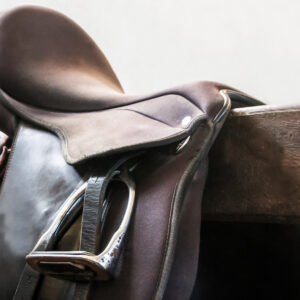Spring has come early for most of us this year and now is the best time to get your schooling jumps and footing prepared for some serious fun. Think of it as spring cleaning—a little maintenance will make your jumps last longer, look more beautiful and even provide a better schooling experience.
Logs eventually rot and wear out. They tend to wear out inconsistently as some last much longer than others. Check them thoroughly and replace logs that are sinking into the ground or rotting away. The same goes for boards. A few rotten boards does not necessarily mean that a portable cross country fence is junk, however. Normally the frame holds up better than the “skin” since it’s not exposed to the elements, so you can re-skin them (replace the outer boards) at least once. Pressure washing and staining portable fences can make them look like new.

For portable jumps, I recommend moving them a few times a year to protect the ground underneath. If a jump sits there for a long time it settles into the ground. Pick them up and put them on new ground to preserve the turf and keep the jumps in better shape.
As for footing, spring is a good time to over seed or reseed—the sooner the better. Some turf experts say you can effectively broadcast seed as the frost comes out of the ground because the ground sort of heaves a bit and the seed gets into the dirt. You can also drill the seed in the spring for the same effect. At the end of winter it’s easier to see the ground itself—the bare patches and the humps and bumps. After the grass comes in it’s less obvious where the patches that need maintenance are located.

Now is also a good time to fertilize. It’s much better to do this early before the grass gets high; you want the fertilizer in the dirt, not in the grass. Different regions have different grasses, so what you use depends on where you are. Local farmers and agriculturalists are generally most helpful. For instance, the mushroom compost in Pennsylvania is inexpensive and very effective. Once you ship it to Virginia, it’s more expensive. In Georgia I’ve seen them use peanut hulls because it’s a local commodity. Ask around to find out if there’s local compost you can use.
Remember that none of this is a quick fix, it’s yearly maintenance. Our goal at Fair Hill is to make 70% of the track 30% better than it was last year. You don’t want to tear it all up and start over, you just want to keep improving what you have. There are a lot of smart people out there who know how to grow grass and manage properties. Again, this time of year you can see what’s going on at the dirt level. By April or May the window is starts to close because in the summer there’s no guarantee of rain.

Competition courses are becoming increasingly new and shiny. Young horses can school all day at local schooling courses that have gotten old and gray, and then you get to a competition with lots of shiny new painted jumps and the young, inexperienced horses react differently to that look. It doesn’t have to look like Disneyland, but you want to give your horses a school that better simulates a competition. Giving your show jumps some shine can make a better schooling experience.
The rebirth of spring tends to motivate us to go outside and get things done. It’s a great time to add a few new jumps or a couple of new portable fences. You tend to get involved more with the horses during the competition season, so now’s a good time to assess if you should add new things.
Pressure washing and repainting jumps will make feel like you have a new set. If the task is too daunting, hire it out; there are contractors who can take care of this and your jumps will last longer. There are a lot of competitions on the calendar in the next few months and now is the time to get yourself prepared at home.


 March 11, 2016
March 11, 2016 

























